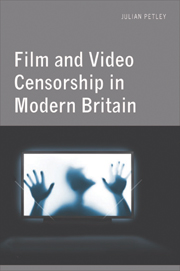Book contents
- Frontmatter
- Contents
- Acknowledgements
- Dedication
- Introduction
- Part I Censorious Rigmarole and Legalistic Overkill
- Part II After the Deluge
- Part III Nineties Nightmares
- 7 ‘Not Suitable for Home Viewing’
- 8 Vicious Drivel and Lazy Sluts
- 9 Doing Harm
- 10 The Anatomy of a Newspaper Campaign: Crash
- 11 The Last Battle, or Why Makin' Whoopee! Matters
- Part IV New Millennium, New Beginning?
- Appendix: The DPP List of ‘Video Nasties’
- Bibliography
- Index
8 - Vicious Drivel and Lazy Sluts
from Part III - Nineties Nightmares
Published online by Cambridge University Press: 05 August 2013
- Frontmatter
- Contents
- Acknowledgements
- Dedication
- Introduction
- Part I Censorious Rigmarole and Legalistic Overkill
- Part II After the Deluge
- Part III Nineties Nightmares
- 7 ‘Not Suitable for Home Viewing’
- 8 Vicious Drivel and Lazy Sluts
- 9 Doing Harm
- 10 The Anatomy of a Newspaper Campaign: Crash
- 11 The Last Battle, or Why Makin' Whoopee! Matters
- Part IV New Millennium, New Beginning?
- Appendix: The DPP List of ‘Video Nasties’
- Bibliography
- Index
Summary
According to most newspapers, British is awash with ‘video nasties’ which are openly available to young children; there is a direct causal link between the video Child's Play 3 and the murders of James Bulger and Suzanne Capper; academics have at long last recognised the ‘obvious’ link between screen violence and real-life crime; and the British Board of Film Classification is irresponsibly liberal in its decisions.
In fact, ‘video nasties’ were outlawed by police action under the Obscene Publications Act even before the Video Recordings Act was passed in 1984; there are no causal links whatsoever between Child's Play 3 and the Bulger and Capper murders, as the police involved in both cases readily testify; there has been no wholesale U-turn by academics on the vexed question of ‘media effects’; and Britain has one of the strictest regimes of film and video censorship in the Western world.
So what lies (and that indeed is the operative word) behind the latest example of the ‘video nasty’ panic which the press was instrumental in igniting in the early 1980s and which with its help has periodically flared into life ever since? The initial impetus clearly lay in attempts to find some sort of explanation for the seemingly inexplicable murder of James Bulger in February 1993. Examine the brutalising, impoverishing and destructive effects of policies carried out in the spirit of the dogma that ‘there is no such thing as society’?
- Type
- Chapter
- Information
- Film and Video Censorship in Modern Britain , pp. 102 - 108Publisher: Edinburgh University PressPrint publication year: 2011



